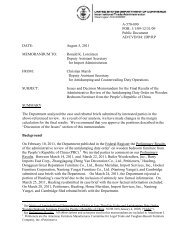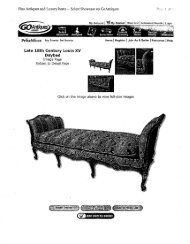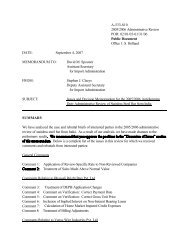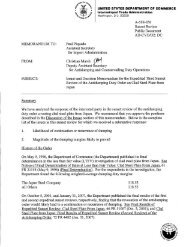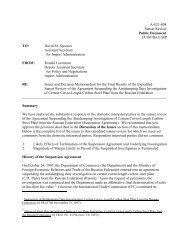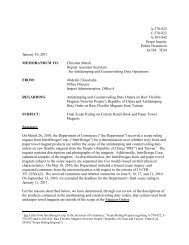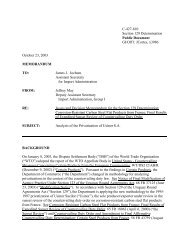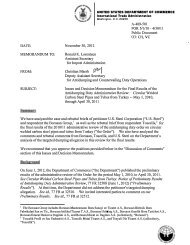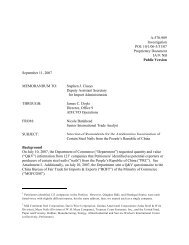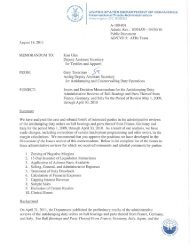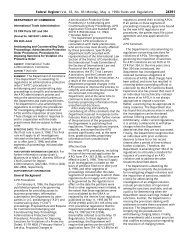Granular Polytetrafluoroethylene Resin from Italy - Import ...
Granular Polytetrafluoroethylene Resin from Italy - Import ...
Granular Polytetrafluoroethylene Resin from Italy - Import ...
Create successful ePaper yourself
Turn your PDF publications into a flip-book with our unique Google optimized e-Paper software.
DATE: March 23, 2009<br />
MEMORANDUM TO: Ronald K. Lorentzen<br />
Acting Assistant Secretary<br />
for <strong>Import</strong> Administration<br />
A-475-703<br />
19th Administrative Review<br />
POR: 08/01/06-07/31/07<br />
Public Document<br />
Office 1: Y. Nair/S. Subler<br />
FROM: John M. Andersen<br />
Acting Deputy Assistant Secretary<br />
for Antidumping and Countervailing Duty Operations<br />
SUBJECT: Issues and Decision Memorandum for the 2006/07 Antidumping<br />
Duty Administrative Review of <strong>Granular</strong> <strong>Polytetrafluoroethylene</strong><br />
<strong>Resin</strong> <strong>from</strong> <strong>Italy</strong><br />
SUMMARY<br />
We have analyzed the case and rebuttal briefs of interested parties in the 2006/07 administrative<br />
review of granular polytetrafluoroethylene resin <strong>from</strong> <strong>Italy</strong>. As a result of our analysis, we have<br />
made changes to the preliminary results. We recommend that you approve the positions<br />
described in the “Discussion of Issues” section of this memorandum. Below is a complete list of<br />
the issues in this review for which we received comments and rebuttals <strong>from</strong> interested parties:<br />
Comment 1: Differences Between Statutory Financial Statements and Financial<br />
Statements Prepared According to International Financial Reporting<br />
Standards<br />
Comment 2: Financial Statements for G&A and Financial Expenses<br />
Comment 3: Goodwill Amortization<br />
Comment 4: Research and Development Expenses and Certain G&A Expenses<br />
Comment 5: Major Inputs<br />
Comment 6: Adjustments to the Cost of Manufacturing<br />
Comment 7: Financial Expenses<br />
Comment 8: Solvay’s Use of Polymist® in Producing In-Scope Products<br />
Comment 9: Non-U.S. Sales<br />
Comment 10: Treatment of Negative Dumping Margins (Zeroing)
BACKGROUND<br />
On September 22, 2008, the Department of Commerce (“Department”) published in the Federal<br />
Register the preliminary results of the nineteenth administrative review of the antidumping duty<br />
order on granular polytetrafluoroethylene resin (“PTFE”) <strong>from</strong> <strong>Italy</strong>. 1<br />
On December 11, 2008, we issued a verification report for the sales response submitted by<br />
Solvay Solexis S.p.A. See Memorandum <strong>from</strong> Shane Subler and Alicia Winston, International<br />
Trade Compliance Analysts, to Susan H. Kuhbach, Director, Office 1, “Verification of the Sales<br />
Response of Solvay Solexis S.p.A. in the Antidumping Duty Administrative Review of <strong>Granular</strong><br />
<strong>Polytetrafluoroethylene</strong> <strong>Resin</strong> <strong>from</strong> <strong>Italy</strong>” (December 11, 2008) (“Home Market Verification<br />
Report”). On January 6, 2009, we issued a verification report for the cost response submitted by<br />
Solvay Solexis S.p.A. See Memorandum <strong>from</strong> Ernest Z. Gziryan, Senior Accountant, to Neal M.<br />
Halper, Director, Office of Accounting, “Verification of the Cost of Production and Constructed<br />
Value Data Submitted by Solvay Solexis S.p.A. in the Antidumping Duty Administrative<br />
Review of <strong>Granular</strong> <strong>Polytetrafluoroethylene</strong> (“PTFE”) <strong>Resin</strong> <strong>from</strong> <strong>Italy</strong>” (January 6, 2009)<br />
(“Cost Verification Report”). On January 9, 2009, we issued a verification report for the<br />
constructed export price (“CEP”) sales response submitted by Solvay Solexis, Inc. See<br />
Memorandum <strong>from</strong> Shane Subler and Alicia Winston, International Trade Compliance Analysts,<br />
to Susan H. Kuhbach, Director, Office 1, “Verification of the Sales Response of Solvay Solexis,<br />
Inc. in the Antidumping Duty Administrative Review of <strong>Granular</strong> <strong>Polytetrafluoroethylene</strong> <strong>Resin</strong><br />
<strong>from</strong> <strong>Italy</strong>” (January 9, 2009) (“CEP Verification Report”).<br />
We invited interested parties to comment on the Preliminary Results. On January 26, 2009, we<br />
received case briefs <strong>from</strong> E.I. DuPont de Nemours & Company (“Petitioner”) and the collective<br />
respondent, Solvay Solexis, Inc. and Solvay Solexis S.p.A. (collectively, “Solvay”). On January<br />
29, 2009, we received rebuttal briefs <strong>from</strong> Petitioner and Solvay. On January 26, 2009, Solvay<br />
requested a public hearing. The Department held the hearing on February 2, 2009.<br />
The period of review (“POR”) is August 1, 2006, through July 31, 2007.<br />
DISCUSSION OF ISSUES<br />
Comment 1: Differences Between Statutory Financial Statements and Financial<br />
Statements Prepared According to International Financial Reporting<br />
Standards<br />
Solvay argues that the Department should not adjust Solvay’s reported costs for items that are<br />
included in the financial statements prepared according to Italian generally accepted accounting<br />
principles (“GAAP”) (i.e., statutory financial statements), but are not on the financial statements<br />
prepared under International Financial Reporting Standards (i.e., Cheops financial statements).<br />
Solvay claims that the statutory financial statements are prepared according to tax rules, and tax<br />
accounting ordinarily is less reflective of economic reality and, thus, is less relevant in the<br />
1 See Amended Notice of Preliminary Results of Antidumping Duty Administrative Review: <strong>Granular</strong><br />
<strong>Polytetrafluoroethylene</strong> <strong>Resin</strong> From <strong>Italy</strong>, 73 FR 54557 (September 22, 2008) (“Preliminary Results”).<br />
2
antidumping context. Solvay cites Final Determination of Sales at Less Than Fair Value:<br />
Antidumping Duty Investigation of Stainless Steel Angle From Japan, 60 FR 16608, 16617<br />
(March 31, 1995), and Fresh and Chilled Atlantic Salmon From Norway; Final Results of<br />
Antidumping Duty Administrative Review, 58 FR 37912, 37915 (July 14, 1993) (“Salmon <strong>from</strong><br />
Norway”), to support its contention that the Department normally does not include tax-related<br />
items in the cost of production (“COP”). Solvay maintains that the items which are recorded in<br />
the statutory financial statements but not on the Cheops statements are financial reporting<br />
adjustments for tax purposes whose inclusion in general and administrative (“G&A”) expenses<br />
would not reasonably reflect the actual POR COP of subject merchandise.<br />
Petitioner suggests that the Department should include in the calculation of Solvay’s G&A<br />
expenses items that are included in the statutory financial statements but are not in the Cheops<br />
financial statements. Petitioner notes that the Department has consistently ruled in the past<br />
reviews of Solvay that it is appropriate to base G&A expenses on the financial statements that<br />
are prepared under the GAAP of the exporting country, i.e., the statutory financial statements.<br />
Petitioner, citing Notice of Final Determination of Sales at Less Than Fair Value: Stainless Steel<br />
Bar From <strong>Italy</strong>, 67 FR 3155 (January 23, 2002), and accompanying Issues and Decision<br />
Memorandum at Comment 48, notes that the Department found in other cases that reliance on<br />
the cases cited by Solvay is misplaced, because, for example, in Salmon <strong>from</strong> Norway the<br />
amount of depreciation in question was not the current income statement cost, but rather an<br />
appropriation to an account that reflected the difference between ordinary depreciation and tax<br />
depreciation.<br />
Department’s Position: We agree with Petitioner. Section 773(f)(1)(A) of the Tariff Act of<br />
1930, as amended (“the Act”), states that the COPs “shall normally be calculated based upon the<br />
records of the exporter or producer of the merchandise, if such records are kept in accordance<br />
with the generally accepted accounting principles of the exporting country…and reasonably<br />
reflect the costs associated with the production and sale of the merchandise.” Because the costs<br />
as reflected in Solvay’s statutory financial statements are not distortive, the Department’s<br />
reliance on the statutory financial statements prepared according to Italian GAAP is in<br />
accordance with law. With regard to cases cited by the respondent, they are not on point,<br />
because these cases refer to adjustments made for tax purposes, while there is no evidence on the<br />
record to support Solvay’s contention that the adjustments in question were made by Solvay<br />
solely for tax purposes. On the contrary, the record indicates that the statutory financial<br />
statements are prepared in accordance with Italian GAAP, and the fact that the same statements<br />
may be used for tax purposes does not mean that they are prepared solely for tax purposes. It<br />
simply means that, in this instance, the Italian GAAP financial statements are also used by the<br />
company for tax purposes.<br />
We also note that the U.S. Court of International Trade and the Federal Circuit have upheld the<br />
Department’s reliance upon a company’s records prepared in accordance with the home<br />
country’s GAAP when portions of those records were prepared solely for tax benefit purposes.<br />
See Thai Pineapple Public Co., Ltd. v. United States, 187 F.3d 1362, 1367 (Fed. Cir. 1999)<br />
(affirming the Department’s reliance upon the company’s records, even though they were<br />
prepared for tax purposes); Laclede Steel Co. v. United States, 18 CIT 965 (Ct. Int’l Trade<br />
1994) (holding that overlooking expenses recorded in a respondent’s financial statements solely<br />
3
for tax purposes would “result in a skewed portrayal of cost of production; by isolating one of<br />
many variables affecting a company’s entire financial picture over a period of time…and<br />
subjecting that variable to accounting principles different <strong>from</strong> those applied to other<br />
variables…”); Slater Steels Corp. v. United States, 297 F. Supp. 2d 1351 (Ct. Int’l Trade 2003)<br />
(affirming Commerce’s use of a financial statement “… prepared in anticipation of a merger to<br />
obtain Italian tax advantages.”).<br />
Finally, we note that the record does not support Solvay’s claim that Italian GAAP is structured<br />
solely for tax purposes. Different accounting standards use different accounting principles to<br />
match revenues and expenses. The Department normally relies upon the standards that follow<br />
the company’s home country’s GAAP because these are the standards upon which a company<br />
has recorded its own revenues and expenses. See section 773(f)(1)(A) of the Act. Therefore, for<br />
the final results, we continue to rely on the statutory financial statements and to include in the<br />
G&A expense ratio calculation the relevant items recorded on the statutory financial statements<br />
which are not in the Cheops financial statements.<br />
Comment 2: Financial Statements for G&A and Financial Expenses<br />
Solvay argues that the Department should use 2007 financial statements for the G&A and<br />
financial expense calculations, because they cover seven rather than five months of the POR.<br />
Solvay, citing Stainless Steel Bar <strong>from</strong> India; Final Results of Antidumping Duty Administrative<br />
Review, 67 FR 45956 (July 11, 2002), and accompanying Issues and Decision Memorandum at<br />
Comment 4, states that it is the Department’s practice to use a fiscal year that corresponds to as<br />
much of the POR as possible. Solvay also refers to Final Determination of Sales at Less Than<br />
Fair Value: Furfuryl Alcohol From Thailand, 60 FR 22557 (May 8, 1995) at Comment 11, where<br />
the Department stated that “(u)nder ordinary circumstances, the most appropriate full-year G&A<br />
period is that represented by the latest fiscal year for which the respondent has complete and<br />
audited financial statements.” Because the 2007 financial statements are the latest complete<br />
statements and cover the majority of the months in the POR, Solvay concludes, they should be<br />
used for the G&A and financial expense ratio calculations.<br />
Petitioner argues that the Department should continue its practice of using Solvay’s financial<br />
statements covering the first part of the POR (i.e., 2006 financial statements) for the G&A and<br />
financial expense ratio calculations, as it did in previous reviews of this case. Petitioner claims<br />
that, to remain consistent with past reviews and to maintain the accuracy and fairness of the<br />
calculation of antidumping duty margins, the Department should continue to use the 2006<br />
financial statements rather than the 2007 statements. Petitioner cites Notice of Final<br />
Determination of Sales at Less Than Fair Value: Carbon and Certain Alloy Steel Wire Rod From<br />
Mexico, 67 FR 55800 (August 30, 2002), and accompanying Issues and Decision Memorandum<br />
at Comment 7 (“Steel Wire Rod <strong>from</strong> Mexico”), where the period of investigation was split<br />
equally between the two fiscal years. Petitioner contends that the Department used the earlier<br />
submitted financial statements for the first part of the period of investigation because this<br />
“afforded parties more time to review and comment on data,” and because it was important to<br />
“be consistent between proceedings.” Petitioner points out that never before has Solvay argued<br />
that the Department should use financial statements for the later part of the POR and it is,<br />
therefore, obvious that it is argued this time solely because the use of 2007 financial statements<br />
4
enefits Solvay. Finally, Petitioner argues that the Department should also take into account the<br />
window period for home market sales. According to Petitioner, when the additional window<br />
months are added, there are eight months in 2006 and nine months in 2007, i.e., the POR is<br />
covered almost equally by each of the two years.<br />
Department’s Position: We agree with Solvay and have relied on fiscal year 2007 financial<br />
statements as the basis for the G&A and financial expense ratio calculations. Our preference is<br />
to base the G&A and interest expense rates on the fiscal year which most closely corresponds to<br />
the POR, because financial statements for that year reflect more months of the company’s<br />
activity during the POR. See Certain Stainless Steel Butt-Weld Pipe Fittings <strong>from</strong> Taiwan: Final<br />
Results and Final Rescission in Part of Antidumping Duty Administrative Review, 67 FR 78417<br />
(December 24, 2002) and accompanying Issues and Decision Memorandum at Comment 8. In<br />
the instant case, the 2007 fiscal year financial statements overlap seven months of the POR,<br />
whereas the 2006 financial statements overlap only five months of the POR. Therefore, the 2007<br />
financial statements are the more appropriate basis for the G&A expense and interest expense<br />
ratios since the portion of the POR in 2007 is longer than the portion of the POR in 2006. In this<br />
regard, Petitioner’s reference to Steel Wire Rod <strong>from</strong> Mexico is not on point, because in that case<br />
the period of investigation was split equally between the two fiscal years. Id. at Comment 7.<br />
We acknowledge that in the past reviews of this case, the Department has accepted Solvay’s<br />
reporting based on the earlier set of the financial statements for its calculations of G&A expense<br />
and interest expense ratios. The Department prefers a consistent methodology <strong>from</strong> segment to<br />
segment; however, we are not compelled to continue with a method that is not our preferred<br />
method for the sake of consistency. See Notice of Final Results of Antidumping Duty<br />
Administrative Review and Final Determination to Revoke the Order In Part: Individually<br />
Quick Frozen Red Raspberries <strong>from</strong> Chile, 72 FR 6524 (February 12, 2007) and accompanying<br />
Issues and Decision Memorandum at Comment 5.<br />
Finally, we disagree with Petitioner that the window period for home market sales is relevant in<br />
determining which fiscal year is more appropriate in calculating the G&A and interest expense<br />
rates. The Department normally calculates its COP for the POR and does not require costs to be<br />
reported for the window periods. Since the costs are reported for the POR, the appropriate<br />
period for reporting G&A and financial expense is the fiscal period which most closely matches<br />
the POR, excluding the window periods.<br />
Comment 3: Goodwill Amortization<br />
Solvay claims that the Department erred in the Preliminary Results by including in G&A<br />
expenses an amount for amortization of goodwill recorded in the company’s 2006 statutory<br />
financial statements. Solvay argues that the amortization of goodwill should not be included in<br />
G&A expenses because the Department should use the 2007 financial statements which show no<br />
amortization of goodwill. Solvay maintains that even if the Department decides to use the 2006<br />
financial statements for the G&A expense calculation, there still should be no adjustment for the<br />
goodwill amortization because the company booked no goodwill amortization during the POR in<br />
either of the 2006 and 2007 calendar years. This is because, according to Solvay, while the<br />
company provisionally continued to record amortization of goodwill during calendar year 2006,<br />
5
the 2006 financial statements were subsequently corrected in 2007, and amortization of goodwill<br />
was recorded as zero. Solvay holds that in any event the Department should not include the full<br />
12 months of goodwill amortization recorded in 2006, because the POR covers only five months<br />
of the calendar year 2006.<br />
Solvay further argues that it experienced no goodwill-related cost during the POR. According to<br />
Solvay, the goodwill at issue arose <strong>from</strong> a 2002 transaction in which Solvay S.A. purchased<br />
Ausimont S.p.A., taking the purchased business forward under the name Solvay Solexis S.p.A.<br />
Solvay contends that Solvay S.A accounted in its own audited financial statements for the<br />
goodwill element of the 2002 purchase price, and that Solvay S.A. as the purchaser is the only<br />
entity that could have experienced an actual cost, in subsequent years, associated with a decline<br />
in the goodwill’s value.<br />
Petitioner, citing Notice of Final Determination of Sales at Less Than Fair Value: Certain Cold-<br />
Rolled Carbon Steel Flat Products From Brazil, 67 FR 62134 (October 3, 2002) and<br />
accompanying Issues and Decision Memorandum at Comment 12, argues that the Department<br />
normally considers goodwill as related to the general operations of the company as a whole and<br />
includes goodwill amortization in the G&A expense ratio calculation. According to Petitioner,<br />
Solvay recorded on its 2006 statutory financial statements that it had amortized the goodwill and,<br />
thus, this amortization must be reflected in the Department’s G&A expense ratio calculation.<br />
Department’s Position: As discussed in Comment 2, above, for the final results, we determined<br />
it appropriate to use Solvay’s 2007 statutory financial statements to calculate the G&A expense<br />
ratio. As such, the issue of whether the goodwill amortization should be included in the G&A<br />
expenses is moot, because Solvay’s 2007 statutory financial statements show no expense<br />
associated with the amortization of goodwill.<br />
Comment 4: Research and Development Expenses and Certain G&A Expenses<br />
Solvay argues that certain research and development (“R&D”) costs and certain G&A expenses<br />
should be excluded <strong>from</strong> the reported costs.<br />
According to Petitioner, these costs should be included in Solvay’s COP.<br />
Department’s Position: We agree with Petitioner. Due to the business proprietary nature of the<br />
information in question, we cannot address the specifics of the arguments in this public<br />
document. We have addressed the arguments in a separate memorandum to the file, which will<br />
be placed on the official record and served upon parties with access to such information under<br />
administrative protective order. See Memorandum <strong>from</strong> Ernest Z. Gziryan, Senior Accountant,<br />
to Neal M. Halper, Director, Office of Accounting, “Cost of Production and Constructed Value<br />
Calculation Adjustments for the Final Results – Solvay Solexis S.p.A.” (“Cost Calculation<br />
Memorandum”).<br />
Comment 5: Major Inputs<br />
Petitioner suggests that the Department should continue to make an adjustment to Solvay’s cost<br />
6
for the purchase of major inputs <strong>from</strong> affiliated companies under the major input rule of section<br />
773(f)(3) of the Act.<br />
Solvay did not comment on this issue.<br />
Department’s Position: We agree with Petitioner, in part. Due to the business proprietary<br />
nature of the information in question, we cannot address the specifics of the arguments in this<br />
public document. We have addressed the respondent’s and Petitioner’s arguments in a separate<br />
memorandum to the file, which will be placed on the official record and served upon parties with<br />
access to such information under administrative protective order. See Cost Calculation<br />
Memorandum.<br />
Comment 6: Adjustments to the Cost of Manufacturing<br />
Petitioner argues the Department should include the three categories of fixed costs excluded by<br />
Solvay in its reported COP.<br />
Solvay argues that one category of the fixed costs should not be included because it relates only<br />
to non-subject products.<br />
Department’s Position: We agree with Petitioner. Due to the business proprietary nature of the<br />
information in question, we cannot address the specifics of these arguments in this public<br />
document. We have addressed the respondent’s and Petitioner’s arguments in a separate<br />
memorandum to the file, which will be placed on the official record and served upon parties with<br />
access to such information under administrative protective order. See Cost Calculation<br />
Memorandum.<br />
Comment 7: Financial Expenses<br />
Petitioner argues that the Department should offset Solvay’s interest expenses to account only<br />
for short-term interest income. Petitioner states that Solvay used total interest income for the<br />
offset despite clear indication that it was not justifiably short-term. Therefore, Petitioner claims,<br />
the Department should deny the entire amount of the interest income offset or, at a minimum, the<br />
interest income should be adjusted based on the ratio of current assets to the total assets, as<br />
indicated in the Department’s findings at verification.<br />
Solvay did not comment on this issue.<br />
Department’s Position: We agree with Petitioner that Solvay’s interest expense calculation<br />
should be adjusted to include as an offset only short-term interest income. In calculating COP, it<br />
is the Department's practice to allow a respondent to offset financial expenses only with shortterm<br />
interest income earned <strong>from</strong> its working capital accounts. See, e.g., Certain Frozen<br />
Warmwater Shrimp <strong>from</strong> Brazil: Final Results and Partial Rescission of Antidumping Duty<br />
Administrative Review, 73 FR 39940 (July 11, 2008), and accompanying Issues and Decision<br />
Memorandum at Comment 9. While Solvay did not provide the details behind the interest<br />
income used as an offset to the reported financial expenses, we disagree with Petitioner that we<br />
7
should deny the entire amount of the interest income offset. Our analysis of Solvay S.A.’s (the<br />
parent company) financial statements indicates that there are current interest bearing assets that<br />
produce short-term interest income. Therefore, for the final results we approximated the shortterm<br />
portion of the total interest income based on the ratio of current assets to total interest<br />
income-producing assets of the parent company, Solvay S.A.<br />
Comment 8: Solvay’s Use of Polymist® in Producing In-Scope Products<br />
Citing the Department’s recent scope ruling in this proceeding, Petitioner notes that the<br />
Department stated its intention to reconsider the scope ruling if it found evidence that Solvay<br />
uses Polymist® feedstock to make raw polymer or granular PTFE. 2 Petitioner contends that the<br />
Department should examine Solvay’s production of Polymist® more closely to ensure that all<br />
necessary information is on the record and that Solvay is not circumventing the order.<br />
Solvay did not comment on this issue.<br />
Department’s Position: During the home market sales and cost verifications, we examined<br />
Solvay’s production process for subject merchandise and its accounting records for any evidence<br />
that Solvay uses, or has used, Polymist® feedstock to produce wet raw polymer or granular<br />
PTFE. First, we traced three lots of Polymist® feedstock produced during the POR <strong>from</strong><br />
Solvay’s inventory records to sales invoices. The records were consistent with our finding in the<br />
Scope Determination Memo that purchasers of Polymist® feedstock (in this case, Solvay’s U.S.<br />
affiliate) expect only to make Polymist® <strong>from</strong> the feedstock. 3 Second, we noted that Solvay<br />
collects Polymist® feedstock at different points of PTFE production, packs the feedstock for<br />
shipment, and does not reintroduce the feedstock back into production of PTFE products. 4<br />
Thus, we found no evidence that Solvay uses, or has used, Polymist® feedstock to produce wet<br />
raw polymer or granular PTFE. As a result, for the final results of this review, we are not<br />
reconsidering our decision in the Scope Determination Memo. We may, however, reconsider our<br />
scope determination in the future if we find evidence that Solvay uses, or has used, Polymist®<br />
feedstock to produce wet raw polymer or granular PTFE.<br />
Comment 9: Non-U.S. Sales<br />
Solvay asserts that the Department’s verification of Solvay’s questionnaire responses revealed<br />
that two sales of subject merchandise to Canada were mistakenly reported as sales to the United<br />
2 See Notice of Scope Rulings, 73 FR 72771, 72772 (December 1, 2008), citing ruling <strong>from</strong> Memorandum to<br />
Stephen J. Claeys, Deputy Assistant Secretary for <strong>Import</strong> Administration, Re: Final Determination in the<br />
Consideration of Polymist® Feedstock as Part of the Current Scope of <strong>Granular</strong> <strong>Polytetrafluoroethylene</strong> <strong>Resin</strong> <strong>from</strong><br />
<strong>Italy</strong> (July 31, 2008) (“Scope Determination Memo”).<br />
3 See Scope Determination Memo at page 17. The verification documents that support this statement are business<br />
proprietary. We review this documentation in the calculation memorandum for these final results. See<br />
Memorandum <strong>from</strong> Yasmin Nair, International Trade Compliance Analyst, to Susan H. Kuhbach, Director, Office 1,<br />
“2006-2007 Administrative Review of the Antidumping Duty Order on <strong>Granular</strong> <strong>Polytetrafluoroethylene</strong> <strong>Resin</strong> <strong>from</strong><br />
<strong>Italy</strong> Final Results Sales Calculation Memorandum - Solvay Solexis, Inc. and Solvay Solexis S.p.A.” (March 23,<br />
2009).<br />
4 See Cost Verification Report at pages 10-11.<br />
8
States. 5 Solvay contends that these sales should be excluded for purposes of calculating the final<br />
results of this administrative review.<br />
Petitioner did not comment on this issue.<br />
Department’s Position: The Department’s verification confirmed that two sales of PTFE made<br />
to Canada were mistakenly included in Solvay’s U.S. sales dataset. We have removed these<br />
sales <strong>from</strong> the margin calculation.<br />
Comment 10: Treatment of Negative Dumping Margins (Zeroing)<br />
According to Solvay, in past segments of this proceeding and in other proceedings, the<br />
Department has not incorporated the full value of negative margins in its calculation of an<br />
overall dumping margin. Solvay argues that this practice has been found World Trade<br />
Organization (“WTO”)-inconsistent in a dispute settlement case involving this proceeding, and<br />
that the United States has officially declared its intention to bring its conduct in the affected<br />
proceedings (including this one) into WTO-conformity. 6<br />
Petitioner did not comment on this issue.<br />
Department’s Position: We have not changed our calculation of the weighted-average dumping<br />
margin as suggested by Solvay for these final results of review.<br />
Section 771(35)(A) of the Act defines "dumping margin" as the "amount by which the normal<br />
value exceeds the export price or constructed export price of the subject merchandise." Outside<br />
the context of antidumping investigations involving average-to average comparisons, the<br />
Department interprets this statutory definition to mean that a dumping margin exists only when<br />
normal value is greater than export or constructed export price. As no dumping margins exist<br />
with respect to sales where normal value is equal to or less than export or constructed export<br />
price, the Department will not permit these non-dumped sales to offset the amount of dumping<br />
found with respect to other sales. The U.S. Court of Appeals for the Federal Circuit has held that<br />
this is a reasonable interpretation of the statute. See, e.g., Timken Co. v. United States, 354 F.3d<br />
1334, 1342 (Fed. Cir. 2004) (“Timken”); Corus Staal BV v. Department of Commerce, 395 F.3d<br />
1343, 1347-49 (Fed. Cir. 2005), cert. denied; 126 S. Ct. 1023, 163 L. Ed. 2d 853 (January 9,<br />
2006) (“Corus I”).<br />
Section 771(35)(B) of the Act defines weighted-average dumping margin as “the percentage<br />
determined by dividing the aggregate dumping margins determined for a specific exporter or<br />
producer by the aggregate export prices and constructed export prices of such exporter or<br />
producer.” The Department applies these sections by aggregating all individual dumping<br />
margins, each of which is determined by the amount by which normal value exceeds export price<br />
or constructed export price, and dividing this amount by the value of all sales. The use of the<br />
5 See CEP Verification Report at pages 2 and 13.<br />
6 See “U.S. Statements at the WTO Dispute Settlement Body Meeting” (May 30, 2006) at Item 1, available at<br />
http://www.us-mission.ch/Press2006/0531DSB.html.<br />
9
term aggregate dumping margins in section 771(35)(B) of the Act is consistent with the<br />
Department's interpretation of the singular “dumping margin” in section 771(35)(A) of the Act as<br />
applied on a comparison-specific level and not on an aggregate basis. At no stage of the process<br />
is the amount by which export price or constructed export price exceeds the normal value<br />
permitted to offset or cancel out the dumping margins found on other sales.<br />
This does not mean that non-dumped sales are disregarded in calculating the weighted-average<br />
dumping margin. It is important to note that the weighted-average margin will reflect any nondumped<br />
merchandise examined during the POR: the value of such sales is included in the<br />
denominator of the weighted-average dumping margin, while no dumping amount for nondumped<br />
merchandise is included in the numerator. Thus, a greater amount of non-dumped<br />
merchandise results in a lower weighted-average margin.<br />
The Federal Circuit explained in Timken that denial of offsets is a “reasonable statutory<br />
interpretation given that it legitimately combats the problem of masked dumping, wherein certain<br />
profitable sales serve to ‘mask' sales at less than fair value.” Timken, 354 F.3d at 1343. As<br />
reflected in that opinion, the issue of so-called “masked dumping” was part of the policy reason<br />
for interpreting the statute in the manner interpreted by the Department. No U.S. court has<br />
required the Department to demonstrate “masked dumping,” before it is entitled to invoke this<br />
interpretation of the statute and deny offsets to dumped sales. See, e.g., Timken, 354 F.3d at<br />
1343; Corus I; Corus Staal BV v. United States, 502 F.3d 1370, 1375 (Fed. Cir. 2007) (“Corus<br />
II”); and NSK Ltd. v. United States, 510 F.3d 1375 (Fed. Cir. 2007) (“NSK”).<br />
Solvay argues that the WTO has found denial of offsets by the United States to be WTOinconsistent.<br />
The U.S. Court of Appeals for the Federal Circuit has held that WTO reports are<br />
without effect under U.S. law, “unless and until such a {report} has been adopted pursuant to the<br />
specified statutory scheme” established in the Uruguay Round Agreements Act. Corus I, 395<br />
F.3d at 1347-49; accord Corus II, 502 F.3d at 1375; NSK, 510 F.3d 1375.<br />
Accordingly, consistent with the Department’s interpretation of the Act, the Department has<br />
continued to deny offsets to dumping based on export transactions that exceed normal value in<br />
this review.<br />
10
RECOMMENDATION<br />
Based on our analysis of the comments received, we recommend adopting all of the above<br />
positions and adjusting all related margin calculations accordingly. If these recommendations<br />
are accepted, we will publish the final results of this administrative review and the final<br />
weighted-average dumping margin in the Federal Register.<br />
AGREE _________ DISAGREE _________<br />
_____________________________<br />
Ronald K. Lorentzen<br />
Acting Assistant Secretary<br />
for <strong>Import</strong> Administration<br />
_____________________________<br />
Date<br />
11



